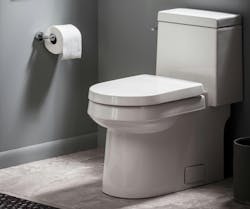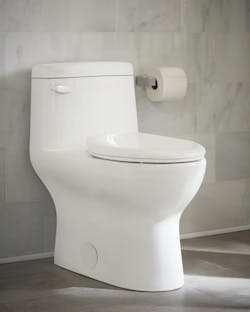Before installing a toilet, homeowners want to be certain it will meet their performance expectations.
“People expect a toilet to work,” says Lovin Saini, senior product manager at Gerber Plumbing Fixtures. “It’s not something you want to think about not working. But the engineering of a toilet is not a simple thing.”
So how are toilets engineered to perform, and what defines strong performance? Saini says it boils down to three C’s: Clear, Clean, and Carry.
“Clear” refers to how much waste the toilet can remove, reflecting the flushing power of the toilet. This is measured with a MaP score, which represents the amount of solid waste a toilet can remove completely with a single flush. The MaP program is an independent voluntary testing program not affiliated with one single manufacturer.
“Clean” refers to the wash of the bowl and the movement of water to remove paper and waste marks. Saini notes that a good cleaning bowl is important because it can prevent the need for double flushing, which wastes water.
“Carry” refers to how far down the drain the waste is carried away from the site. Saini says while this is commonly overlooked, it’s especially important because clogs often happen further down in the pipes.
The American Society of Mechanical Engineers (ASME) sets the industry standard for drain line carry. To test this, engineers pour 100 plastic marbles into a toilet attached to a transparent drain line and record the average travel distance for the marbles. The industry standard for drain line carry is 40 feet.
Saini says another key factor of toilet performance is water conservation. He notes that if a toilet is WaterSense certified, it has passed rigorous performance standards that must be met even when flushing a toilet at a lower flow rate.
A toilet that fails to perform in these areas can bring serious consequences.
“Other than the obvious desire to avoid clogs, stains, or lack of waste removal, consequences include an over-usage of water,” Saini says. “By not having a high-performing toilet, some might be forced to flush multiple times and use double the water necessary. Of course, clogs can also cause significant water damage in a property if it affects pipes and backup.”
In commercial settings, poor toilet performance can also cost businesses revenue and result in a poor customer experience.
Luckily for homeowners, builders, and plumbers alike, innovations and improvements in the understanding of fluid dynamics have led to the creation of a variety of high-performance products.
“Various contributions in the areas of material sciences, manufacturing methodologies, and fluid dynamics have enabled many top brands to significantly improve toilet performance,” Saini says.
He adds that one of the biggest innovations has been the manufacturing of finely-tuned trapways that provide greater siphon and suction power to drive improved power and drain line carry. At the forefront of today’s toilet manufacturing is a focus on bowl hygiene and water conservation, Saini says.
Gerber has long been committed to developing high-performance toilets built for residential and commercial applications. Saini says their products especially take into account the core constituency of plumbers, who need to be able to install toilets with efficiency and ease (and without callbacks).
“Our flush engines are finely-tuned to the exact needs of where plumbers install products and what flush performance and install efficiencies are needed,” he says.

